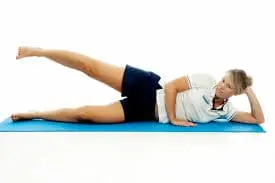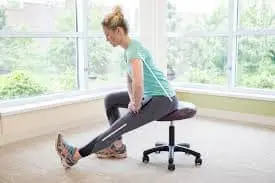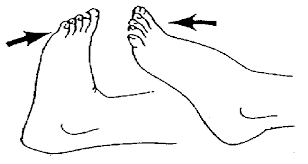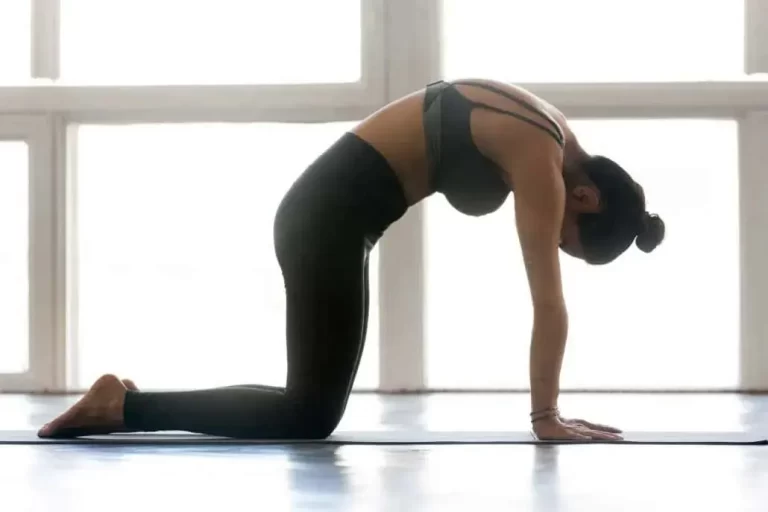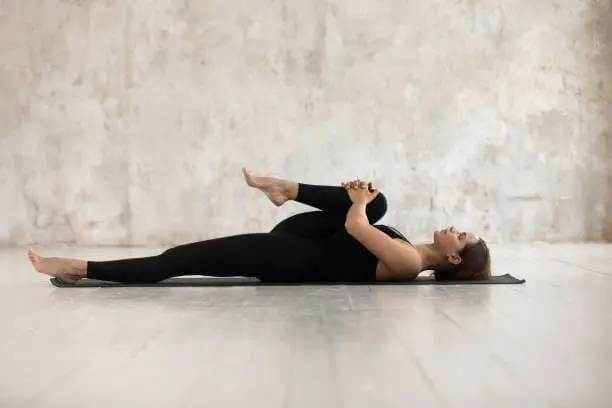20 Best Exercises for Total Hip Replacement
Total hip replacement requires a structured exercise routine to regain strength, mobility, and stability. Key exercises focus on a gentle range of motion, muscle strengthening, and balance to support recovery. Always follow medical advice and progress gradually to ensure safe rehabilitation.
Introduction:
The pelvis, which is composed of the ischium, pubis, and ilium, and the thighbone (femur), make up the hip joint, which is a ball and socket joint. The acetabulum creates the hip joint’s socket, while the femoral head forms the ball. Ligaments, cartilage, and muscles that maintain joint stability are positioned by the acetabulum (socket), deepening the joint.
During total hip replacement (THR) surgery, an artificial implant replaces a broken hip joint. Following surgery, exercise and rehabilitation are essential for regaining function, strength, and mobility.
Following a total hip replacement, it’s important to gradually resume daily activities and engage in regular Exercises for Total Hip Replacement to rebuild hip strength and mobility. Your physical therapist and orthopedic physician could advise you to work out for 20 to 30 minutes each day.
When you are able, begin the exercises. Soon after surgery, you can start them in the recovery area. These activities will improve your recovery and really lessen your post-operative pain, even though they may cause pain initially.
Causes:
An artificial implant is used to replace a broken hip joint during a total hip replacement (THR) surgery. It is typically carried out when there is a significant injury to the hip joint, resulting in chronic pain, tightness, and restricted movement. The following are the most frequent reasons why a hip replacement is required:
Osteoarthritis
A degenerative joint disease called osteoarthritis (OA) occurs through the gradual deterioration of cartilage. As a cushion between bones, cartilage permits fluid motion. Bones rub against one another as they breaks down, causing joint injury, stiffness, and pain.
- Friction between bones results from the degeneration of the hip joint’s cartilage.
- Walking and other daily tasks become challenging as a result of the pain, edema, and stiffness this causes.
- The joint becomes unstable and affected as Osteoarthritis worsens, resulting in significant impairment.
Hip Trauma and Fractures
A hip fracture, which often comes on by falls or accidents, is a break in the upper portion of the femur (thigh bone).
- Particularly in senior people, severe fractures may not heal properly.
- In many cases, if the bone cannot be fixed with other surgical techniques (such as pins or plates), a hip replacement is necessary.
- Post-traumatic arthritis, in which cartilage decreases as a result of previous traumas, can also be caused by trauma.
Inflammatory arthritis, including rheumatoid arthritis (RA)
An autoimmune condition known as rheumatoid arthritis (RA) causes ongoing inflammation and joint degeneration when the body’s immune system unintentionally targets joint tissues.
- Prolonged inflammation causes swelling, pain, and deformity by destroying bone and cartilage.
- Extreme stiffness and immobility result from the joint’s loss of function.
- Eventually, irreparable damage requires surgery.
Hip dysplasia (hip disorders that develop)
Joint instability results from hip dysplasia, a congenital (birth) disorder in which the hip socket is excessively small or malformed.
- Early arthritis results from unequal joint wear caused by an incorrectly formed hip socket.
- The hip joint may eventually become damaged and need to be replaced.
Following Traumatic Injury, Arthritis
When a previous injury (fracture, dislocation, or ligament rupture) results in chronic joint damage and arthritis, it is known as post-traumatic arthritis.
- Joint injuries can eventually lead to Degeneration of cartilage even after they have healed.
- Causes aches, pains, and a reduction of movement, much like osteoarthritis.
Osteonecrosis of the Hip, or Avascular Necrosis
Avascular necrosis (AVN), sometimes referred to as osteonecrosis, is a condition in which bone cells die as a result of a decreased or restricted blood supply to the femoral head (hip bone).
- Joint deformity results from the femoral head collapsing as bone cells degenerate and die.
- This results in severe pain, instability, and symptoms similar to arthritis.
- Joint preservation becomes impossible after the bone fails, requiring a total hip replacement.
Additional Health Issues That Could Cause Total Hip Replacement
Hemophilia
- A blood condition that frequently bleeds joints, causing arthritis and degeneration of cartilage.
Paget’s Bone Disease
- A long-term condition that weakens and breaks bones by interfering with natural bone rebuilding.
- This may ultimately result in joint degeneration and hip arthritis.
Being overweight
- Being overweight causes constant strain on the hip joint, which speeds up cartilage degeneration and raises the possibility of developing arthritis.
Signs and symptoms:
When hip pain, stiffness, and mobility problems become severe and significantly interfere with day-to-day functioning, a complete hip replacement (THR) is typically considered. Making educated treatment decisions can be helped by being aware of the early and advanced symptoms that point to the need for a hip replacement.
Chronic Hip Pain
- Persistent ache that remains even when at rest for weeks or months.
- Pain that gets worse as you move (e.g., walking, standing, climbing stairs).
- Ache at night that keeps you from sleeping, even if you’re lying down.
- Knee, buttock, thigh, or groin pain (referred pain).
- Pain that neither medicine nor physical therapy can alleviate.
Walking Challenges and Mobility Problems
- Hip pain might cause limping or an irregular walk.
- Trouble standing, climbing stairs, or walking long distances.
- Feeling unstable or as though the hip would “give out.”
- Requiring help to get around, such as a walker, cane, or other gadgets.
Restricted Range of Motion with Hip Stiffness
- Having trouble rotating or bending the hip (e.g., putting on shoes or socks).
- When you move, you could feel as though your hip is “locked” or “frozen.”
- Having difficulty getting into and out of a car, bed, or chair.
- Reduced flexibility, which makes daily motions more difficult.
Deformity of the Hip Joint or Changes in Structure
- Differences in leg length: One leg may seem longer or shorter than the other.
- Noticeable hip alignment alterations or deformities.
- The sensation of bone-on-bone friction, popping, or crushing.
Hip Joint Inflammation and Swelling
- Redness, warmth, or swelling in the hip area.
- Increased soreness and stiffness after extended sitting especially in the morning.
- Increasing inflammation caused by joint injury or arthritis.
Conservative Treatments Don’t Help
- Even taking painkillers, steroids, and NSAIDs, the pain still exists.
- Injections of cortisone lose their effectiveness.
Benefits of Exercises:
After a complete hip replacement, exercise is essential for mobility, rehabilitation, and long-term success. Frequent exercise improves general health, joint flexibility, and muscular strength, which helps the new hip endure longer and function correctly. A thorough explanation of the advantages of exercising following hip replacement is provided below:
Increases Healing and The recovery process
Frequent exercise promotes healing and restores normal joint function, which speeds up recovery after surgery.
- Increases blood flow to the surgery site, promoting quicker tissue healing.
- Maintains fluid movement, which reduces swelling and irritation.
- Keeps the hip joint from becoming stiff and developing scar tissue.
- Improves general mobility through improved nerve and muscle function.
Lessons Stiffness and Pain
- By increasing joint flexibility and decreasing inflammation, exercise helps in pain management.
- Keeps the hip joint flexible, avoiding pain and stiffness.
- Reduces the need for painkillers by encouraging the release of endorphins, which are natural painkillers.
- Improves joint lubrication, resulting in more fluid movement.
Improves Leg and Hip Muscle Strength
The hip joint becomes less stable following surgery as the surrounding muscles weaken. Muscle support for the new hip implant is increased by strengthening workouts.
- Quadriceps, hamstrings, and gluteal muscles are strengthened to help with movement.
- Hip stability is improved, lowering the chance of falls or dislocated joints.
- Balance and coordination are restored, improving everyday tasks.
Improves Flexibility and Mobility
Patients may have trouble bending, walking, or climbing stairs after hip replacement. Flexibility and mobility are restored through exercise.
- Increases hip joint range of motion, which facilitates mobility.
- Gait retraining helps in the restoration of regular walking patterns.
- Makes it simpler to stand, sit, and bend while performing daily tasks.
Helps in Preserving a Healthy Weight
The hip joint is stressed by excess body weight, which shortens the implant’s life. Maintaining a healthy weight and preventing more joint damage are two benefits of exercise.
- Increases metabolism and burns calories.
- Prolongs the hip implant’s lifespan by reducing joint strain.
- Prevents effects like diabetes and heart disease that are linked to fat.
Improves Circulation and Prevents Blood Clots
Due to restricted mobility following surgery, deep vein thrombosis (DVT) is a danger. Exercise lowers this risk by maintaining healthy blood flow.
- Reduces the risk of clot formation by preventing blood from collecting in the legs.
- Improves the hip area’s availability of oxygen and nutrients, helping in the healing process.
- Reduces leg numbness and edema following surgery.
Improves Confidence and Mental Health
Anxiety or sadness might result from the mental strain of hip replacement surgery. Exercise improves emotional and mental wellness.
- Reduces stress and improves mood by releasing serotonin and endorphins.
- Resuming regular activities is made possible by an increase in self-confidence.
- It lessens the sense of dependence on other people.
Increases the Hip Implant’s Duration
A strong, active lifestyle lowers the chance of revision surgery by extending the life of the artificial hip joint.
- Improves bone and muscle strength, improving implant support.
- Lowers the chance of hip implant dislocation or loosening.
- Prevents long-term issues by maintaining the joint’s flexibility and functionality.
Exercises for Total Hip Replacement:
Ankle Pumps
After total hip replacement (THR), ankle pumps are a basic yet important activity. They lessen leg edema, improve blood circulation, and prevent blood clots (deep vein thrombosis, or DVT). Following surgery, this exercise can be done immediately, and it should be done regularly while recovering.
- With your legs spread out in front of you, lie on your back (on a chair or bed).
- Keep your feet slightly apart and your legs relaxed.
- Point your toes down slowly, as if you were pressing a gas pedal.
- Hold this position for a few seconds.
- Next, move your toes as close to your shin as you can.
- Then return to your neutral position.
- Then relax.
- Repeat these exercises 5 to 10 times.
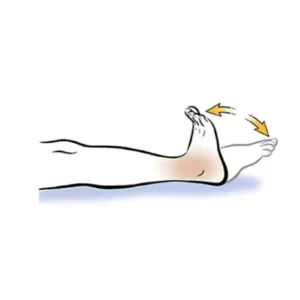
Heel Slides
Following total hip replacement (THR), heel slides are an essential exercise to help strengthen leg muscles, increase range of motion, and restore knee and hip mobility. Early on in the recovery process, they are typically introduced.
- On a level surface, such as a bed or mat, lie on your back.
- Stay calm and with both legs outstretched.
- Slide your heel toward your buttocks while you slowly bend your operated knee.
- Throughout the action, keep your foot planted on the floor or bed.
- Don’t bend too much; stop at a comfortable length.
- Return to the beginning position by slowly straightening your leg.
- Then return to your neutral position.
- Then relax.
- Repeat these exercises 5 to 10 times.
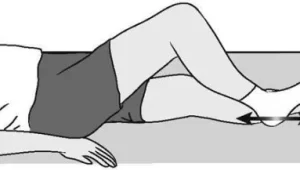
Gluteal Squeezes
Following a total hip replacement (THR), gluteal squeezes, often known as “buttock contractions,” are a straightforward but beneficial workout. They help in strengthening the gluteal muscles, which are essential for walking, hip stability, and general recovery.
- Sit comfortably in a chair or lie on your back on something firm, such as a bed or mat.
- Maintain an upright and relaxed posture with both legs.
- As firmly as you can, squeeze your buttocks together.
- For five to ten seconds, hold the contraction.
- Then return to your neutral position.
- Take a few moments to relax and rest.
- Repeat these exercises 5 to 10 times.
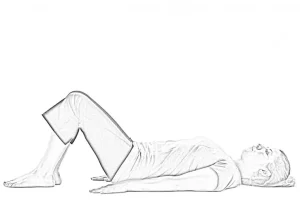
Quadriceps Sets
Quadriceps sets, sometimes referred to as “quad squeezes,” are an important post-total hip replacement (THR) exercise. They provide mobility for walking and other activities, strengthen the quadriceps, and stabilize the knee.
- On a bed or other stable surface, rest on your back with your legs outstretched.
- Make sure your legs are straight and relaxed.
- Pushing the back of your knee down toward the bed will help you contract your quadriceps, or thigh muscles.
- Hold this position for a few seconds.
- Then return to your neutral position.
- Then relax.
- Repeat these exercises 5 to 10 times.
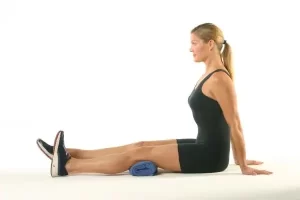
Supine hip abduction and adduction
Following a total hip replacement (THR), supine hip abduction and adduction exercises are essential to improve hip mobility, build muscle, and regain stability when walking. These exercises focus on the hip adductors (inner thigh) and abductors (outer thigh), which are essential for mobility and balance.
- On a level surface, such as a bed or mat, lie on your back.
- Maintain a comfortable and upright posture.
- Maintaining a straight knee, slide your operated leg out to the side.
- Don’t push yourself; merely move within a comfortable range.
- Hold this position for a few seconds.
- Return your leg to the center slowly.
- Then squeeze the muscles in your thighs between your knees as you slowly draw your legs together.
- To pull the legs together without utilizing speed, contract the muscles in your inner thighs.
- Then return to your neutral position.
- Then relax.
- Repeat these exercises 5 to 10 times.
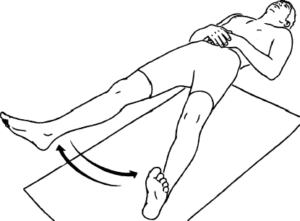
Supine Short Arc Quad
The quadriceps muscles (front of the thigh) can be strengthened with Short Arc Quad (SAQ) workouts without overtaxing the hip joint. After a total hip replacement (THR), this exercise helps strengthen the legs and knees, which makes walking and other daily tasks simpler.
- On a level surface (mat or bed), lie on your back.
- Put a foam roller or rolled towel underneath your operated knee that is roughly 6 inches thick.
- Your heel should rest on the surface, and your knee should be slightly bent.
- To straighten your knee, contract the quadriceps muscles in your thighs.
- The back of your knee should remain on the towel or roller as you raise your heel off the ground.
- After a few seconds of holding, carefully put your foot back down.
- Then return to your neutral position.
- Then relax.
- Repeat these exercises 5 to 10 times.
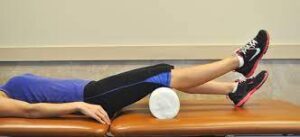
Bridging
The gluteal (buttock) and core muscles are essential for hip stability, posture, and walking following a total hip replacement (THR), and bridging is a fantastic exercise to develop them. However, because it requires hip mobility, you should only do this exercise if your surgeon or physical therapist has given permission to do so.
- Rest on your back on a level surface, such as a mat or bed.
- With both knees bent, maintain a hip-width distance between your flat feet on the floor.
- Maintain your arms by your sides for stability.
- Your glutes (buttocks) and core muscles should be tight.
- Raise your hips slowly off the ground so that your shoulders and knees make a straight line.
- Hold the position for a few seconds.
- Return to the beginning position by lowering your hips gradually.
- Then return to your neutral position.
- Then relax.
- Repeat these exercises 5 to 10 times.
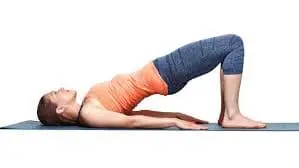
Seated hamstring stretch
An easy and effective way to increase the flexibility of your hamstrings (the muscles at the back of your thigh) is to perform the seated hamstring stretch. Keeping the hamstrings flexible after a total hip replacement (THR) is essential for enhancing mobility, preserving hip function, and avoiding stiffness.
- With your feet flat on the ground and your knees at a 90-degree angle, take a seat on the edge of a sturdy chair.
- With your heel on the ground and your toes pointed up, extend one leg straight out in front of you.
- The foot is flat on the ground and the other leg is still bent.
- Bend forward slowly from your hips, not your back, in the direction of the outstretched leg.
- Your hands should be extended toward your toes (or, if more comfortable, your shin).
- The back of your thigh (hamstring) should feel somewhat stretched.
- Hold this position for a few seconds.
- Then return to your neutral position.
- Then relax.
- Repeat these exercises 5 to 10 times.
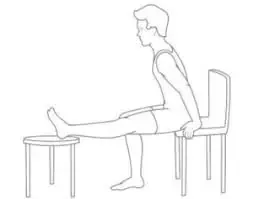
Clamshells
The gluteus medius and minimus, two hip abductor muscles that are essential for hip stability, balance, and general mobility following a total hip replacement (THR), can be strengthened with the clamshell exercise. Walking, standing, and climbing stairs all depend on the muscles supporting your new hip joint being strong again, which is what this exercise helps you achieve.
- Place your operated leg on top of your side (if you’re working on your operated hip).
- Your feet should remain positioned on top of one another while you bend both knees to a 45-degree angle.
- For support, position your arm beneath your head and rest your head on a cushion.
- Your bottom arm can be used to balance your upper body or it can be placed in front of you.
- Involve your glutes and core (buttock muscles).
- As you slowly lift your top knee, pretend that you are opening a clamshell.
- Avoid rotating your body and maintain a hip-stacking position with your feet together.
- Lift the knee as high as it feels comfortable while keeping your pelvis in place.
- Hold this position for a few seconds.
- Then return to your neutral position.
- Then relax.
- Repeat these exercises 5 to 10 times.
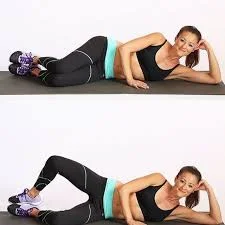
Straight leg raise
Following a total hip replacement (THR), the straight leg raise (SLR) is a basic exercise for building stronger quadriceps, hip flexors, and core muscles. This workout strengthens your leg muscles, particularly the front of the thigh, which is important for standing, walking, and recovering your range of motion.
- Place yourself on your back on a level surface, like a mat or bed.
- Your foot should be flat on the floor as you bend one knee.
- Your opposite leg should remain relaxed and straight.
- To provide stability, position your arms by your sides palms down.
- Tighten your quadriceps, the muscles on top of your thigh, using the straight leg.
- While keeping your knee straight, slowly raise your leg to about the height of your bent knee.
- Hold this position for a few seconds.
- With control, slowly drop your leg back to the ground.
- Then return to your neutral position.
- Then relax.
- Repeat these exercises 5 to 10 times.

Standing Hip Abduction
Following a total hip replacement (THR), the standing hip abduction exercise is an excellent method to strengthen the hip abductors, which are the muscles on the outside of the hip and thigh. Walking, standing, and general functional movement all depend on improved hip stability, balance, and mobility, all of which are improved by this exercise.
- Keep your balance by standing up and gripping a strong chair, countertop, or other support.
- Maintain a straight posture and an engaged core by placing your feet hip-width apart.
- Maintain a small bend in your knees and balance your weight on both legs.
- With your knee straight and your toes pointed front, slowly raise your operated leg out to the side (abduct).
- Throughout the exercise, maintain an upright and engaged body rather than slanting your upper body to one side.
- Raise your leg only as high as it will be pain-free, usually between 30 and 45 degrees.
- Hold this position for a few seconds.
- Afterward, carefully return your leg to the initial position.
- Then relax.
- Repeat these exercises 5 to 10 times.
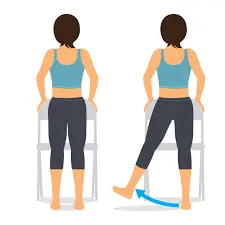
Seated Knee Extensions
Following a total hip replacement (THR), seated knee extensions are a great way to strengthen the quadriceps (front of the thigh) muscles. Walking, standing, and carrying out daily tasks all depend on improved knee stability, leg strength, and general mobility, all of which are improved by this activity.
- Your feet should be flat on the ground when you sit in a sturdy chair.
- Put your legs hip-width apart while maintaining a straight back and a strong core.
- A 90-degree bend should be created by your knees.
- Stretch (straighten) one leg out in front of you slowly, making sure the knee remains straight.
- For the quadriceps to be fully activated, hold the extended leg for a few seconds.
- Return the leg to the beginning position by lowering it slowly, being careful to regulate the movement as you do so.
- Then relax.
- Repeat these exercises 5 to 10 times.
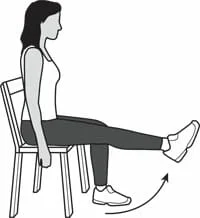
Standing Hip Extensions
Strengthening the gluteal (buttock) muscles and hip extensors is the goal of the standing hip extension exercise. These muscles are essential for function, mobility, and stability following a total hip replacement (THR). Improving posture, balance, and the capacity to carry out daily tasks like walking, climbing stairs, and getting in and out of seats are all made easier by strengthening these muscles.
- Hold onto a stable chair, worktop, or other support for balance while you stand up.
- Your knees should be slightly bent, and your feet should be hip-width apart.
- Maintain an upright posture by using your core muscles.
- Do not round or arch your lower back; instead, maintain a straight back.
- With your knee straight and your toes pointed down, slowly raise your operated leg backward behind you.
- Refrain from bending forward or sideways and instead use your glutes (buttocks) to control the movement.
- Only lift your leg as high as it feels comfortable.
- Hold this position for a few seconds.
- Then return to your neutral position.
- Then relax.
- Repeat these exercises 5 to 10 times.
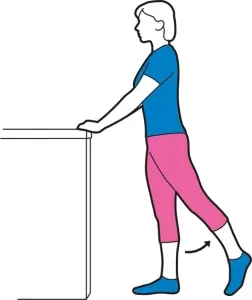
Marching in standing
Following a total hip replacement (THR), the marching in standing exercise is a straightforward yet beneficial way to enhance hip strength, balance, and coordination. Walking, climbing stairs, and other everyday activities all depend on your ability to control and use your legs in a functional, coordinated manner, which this exercise helps you regain.
- Your feet should be hip-width apart as you stand straight.
- If you need support, lean against a wall, a solid chair, or a countertop.
- For balance, maintain a small bend in your knees.
- As if you were walking, raise one leg off the ground and march in place by bringing your knee up to your chest at a 90-degree angle.
- At the highest point of the exercise, pause for a few seconds and use your core and hip flexors.
- Return your foot to the floor slowly.
- Simulate a natural marching motion by switching legs and repeating the process.
- Keep your movements under control and refrain from jerking.
- Then return to your neutral position.
- Then relax.
- Repeat these exercises 5 to 10 times.
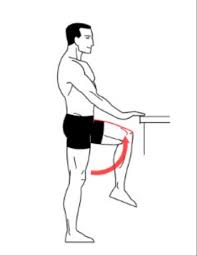
Resistance hip abduction
The hip abductors, or the muscles on the outside of your hip, are essential for stabilizing the hip joint and increasing mobility. The supine hip abduction with theraband exercise is a fantastic method to strengthen these muscles. This exercise can assist you in regaining hip strength and stability following a total hip replacement (THR), which is necessary for walking, standing, and carrying out daily tasks.
- Place yourself on a hard surface, like a mat or bed, and lie on your back.
- Wrap a theraband, or resistance band, around your thighs, a little above your knees.
- You can use a towel or belt to help with resistance if you don’t have a resistance band, but a theraband works better.
- With one leg extended straight out on the floor, bend the opposite knee so that the foot is flat on the ground.
- To keep your spine neutral during the workout, contract your core muscles.
- With the theraband resisting, slowly press your extended leg outside by abducting (pushing the leg away from your body).
- To move the leg, keep your knee straight and concentrate on using your hip muscles rather than your knee or foot.
- For a few seconds, hold the extended leg in the abducted position to activate the hip muscles completely.
- Return the leg to the beginning position gradually while avoiding the pull of the band to ensure controlled movement.
- Then relax.
- Repeat these exercises 5 to 10 times.
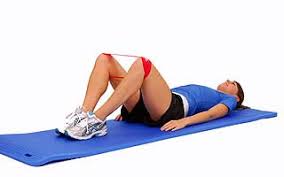
Resistance hip extension
After a total hip replacement (THR), the resistance hip extension exercise is a very good way to strengthen the lower back muscles, hip extensors, and glutes (buttock muscles). Improving walking, hip stability, and general mobility requires strengthening these muscles. Ankle weights or a resistance band are examples of resistance that you might use to gradually develop these muscles during your recovery.
- Hold onto a solid surface, such as a wall, countertop, or chair, for balance and support when standing up.
- Maintain knee bend and hip-width distance between feet.
- Securely fasten the resistance band behind you if you’re using one (for example, by wrapping it around a door handle or other solid object). Ankle weights around your operated leg are an alternative.
- To keep your back from arching too much and to keep your posture straight, use your core muscles.
- Maintaining a straight knee and pointed toes, slowly stretch your operated leg backward.
- Avoid using speed and instead concentrate on pushing your leg back using your glutes (buttocks) and hip extensors.
- To fully stimulate the muscles, squeeze your glutes for a few seconds while you are in the extended posture.
- With control and resistance of the band’s pull, carefully move your leg back to the beginning position.
- Then return to your neutral position.
- Then relax.
- Repeat these exercises 5 to 10 times.
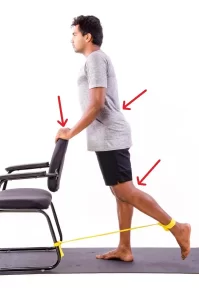
Hip abduction in side lying
Side-lying exercises that include hip abduction are great for building up the gluteus medius and gluteus minimus muscles, which are the hip abductors. In the healing process following a total hip replacement (THR), these muscles are essential for maintaining proper walking mechanics, stabilizing the pelvis, and improving balance.
- If you are working on your operated hip, lie on your non-operated side on a level surface, like a bed or exercise mat.
- For stability, bend your lower knee slightly while maintaining a straight upper leg.
- Your hips and shoulders should be directly placed on top of one another.
- Keep your arms by your sides for support, or place them in front of you.
- Your spine and pelvis will remain more stable if you use your core.
- Maintaining your upper leg straight and in line with your body, raise it without turning your toes outward.
- You don’t have to raise the leg to thirty to forty-five degrees.
- Take a few moments to pause at the highest point and feel your gluteal muscles contracting.
- Controllably lower the leg back down, avoiding gravity as you do so.
- Then return to your neutral position.
- Then relax.
- Repeat these exercises 5 to 10 times.

Mini Squats
A fantastic exercise for strengthening the quadriceps, glutes, and hamstrings all important in stabilizing the hip joint following a total hip replacement (THR)—is the mini squat. Regaining functional mobility and improving one’s capacity to stand, sit, and move more effectively can be achieved with this low-impact exercise.
- Place your toes forward or slightly outward while standing with your feet shoulder-width apart.
- Use your core muscles and maintain an even weight distribution on both feet.
- To stay balanced, use a wall, a solid chair, or a countertop for support.
- Push your hips back and down to get into a squat position, bending your knees slightly (like sitting in a chair).
- Usually, the thighs should be at a little inclination or roughly 30 to 45 degrees from the ground.
- Only drop as far as feels comfortable.
- Keep your knees from going past your toes and maintain an upright chest.
- Hold this position for a few seconds.
- Then carefully push through your heels and straighten your knees to stand back up.
- Then return to your neutral position.
- Then relax.
- Repeat these exercises 5 to 10 times.

Standing Heel Raises
Standing heel raises are a great way to develop your lower legs, ankles, and calf muscles (gastrocnemius and soleus). They also help you maintain your balance by using your hip and core muscles. Since these muscles are essential for posture, walking, and standing, heel raises are a key exercise to help improve functional movement following a total hip replacement (THR).
- With your toes pointed forward and your feet hip-width apart, take a straight position.
- Put your hands on a solid surface for balance, like a wall, chair, or countertop.
- Avoid arching your lower back and maintain proper posture by using your core muscles.
- Maintain a small bend in your knees to improve control.
- Raise your heels slowly off the ground by pushing through your foot pads (not your toes) and into the heel of your feet.
- Using your calf muscles, stand tall for a few seconds at the top of the exercise.
- Gently return your heels to the floor, controlling your lower and avoiding gravity.
- Throughout the workout, pay attention to keeping your posture and balance correct.
- Then return to your neutral position.
- Then relax.
- Repeat these exercises 5 to 10 times.
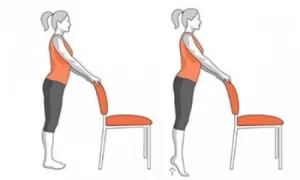
Walking
Following a total hip replacement, walking is a great exercise for rehabilitation and long-term mobility (THR). It lessens stiffness and prevents blood clots while increasing strength, flexibility, and endurance.
- To relax the load on the replacement hip, start with crutches or a walker.
- Make the gradual switch to using a cane and then walking independently.
- Several short walks of five to ten minutes each day are better than a lengthy one.
- Your surgeon will determine if you require partial weight-bearing at first or if you can bear weight in whole.
- Avoid leaning on the walker, take tiny, purposeful steps, and maintain a straight back.
- Don’t turn at the hip; move your complete body.
Which safety measures need to be considered when exercising?
After a complete hip replacement, exercise is essential for healing, but it must be done carefully to avoid dislocation, injury, or implant degeneration. Important safety measures and a list of suggested workouts for various stages of rehabilitation are provided below.
Observe the hip precautions that your surgeon has prescribed.
Depending on the type of hip replacement (posterior, anterior, or lateral approach), your doctor could advise taking particular precautions.
- The most popular posterior strategy is to avoid twisting your leg inward and bending your hip past 90 degrees.
- Avoid external rotation and excessive hip extension while using an anterior approach.
Properly Warm Up and Cool Down
- Before working out, begin with a quick walk, some light stretches, or ankle pumps.
- Stretch gently to increase flexibility at the end.
Begin slowly and make progress over time.
- Start with mild strength and range-of-motion exercises.
- Only increase the intensity if there is no pain.
If you experience any pain, stop right away.
- Sharp pain, swelling, or clicking sounds are warning indications, but mild muscle soreness is typical.
- See your surgeon or physical therapist if your pain doesn’t go away.
If necessary, make use of assistive devices.
- As directed, use a cane or walker, particularly during the first few weeks.
- For support, do the exercises close to a chair or railing.
Keep Your Posture Correct
- Avoid excessive hip bending by sitting on a high, solid chair.
- Keep your distance from deep chairs or low sofas that demand a lot of bending.
When did you stop exercising?
Following a total hip replacement (THR), exercise is essential for the rest of one’s life to preserve joint health, strength, and flexibility. However, there are many situations in which you ought not to continue or modify your workouts.
Severe or Sharp Pain
- While some muscular soreness is natural, severe, sharp, or stabbing pain should be taken seriously.
- A stretched muscle or tendon, nerve injury, or implant loosening could be the cause.
A leg that feels unstable or weak
- Stop working out if your hip seems like it’s “giving out” or if one leg feels noticeably longer or shorter.
- May be a sign of dislocation, joint instability, or an implant alignment problem.
Increased Stiffness or Swelling
- While mild swelling is normal, excessive or chronic swelling may be a sign of inflammation, joint pain, or overuse.
- Stiffness may indicate scar tissue growth or joint impingement if it gets worse rather than better.
Feeling lightheaded, dizzy, or having trouble breathing
Could suggest:
- Dehydration or low blood pressure, particularly during the initial stages of recuperation.
- If calf pain or swelling is present, it may indicate a blood clot (deep vein thrombosis, or DVT).
- A pulmonary embolism is a dangerous condition that needs immediate medical attention.
Unexpected Weakness or Control Loss
A sudden weakness or difficulty moving your leg could be a sign of:
- Nerve damage.
- Fatigue or strain on the muscles.
- A blood clot or poor circulation.
The sensations of clicking, popping, or crushing
While a slight clicking sound may be typical, strong popping, crushing, or shifting sounds could indicate:
- Hip dislocation (a serious health concern).
- Implant wear or misalignment (needs assessment).
Heat, Redness, or Incisional Drainage
- Infection may be indicated if, weeks or months after surgery, the surgical site becomes bloated, red, heated, or begins to leak fluid.
- Stop working out and get medical help right away.
Having a hip replacement Which workouts should be avoided?
Exercises that could raise stress, cause dislocation, or prematurely wear down the implant should be avoided after a complete hip replacement in order to protect the new joint. A thorough guide on exercises and movements to avoid, along with safer alternatives, may be found below.
High-impact activities (risk of implant wear and excessive stress)
The prosthetic hip joint is subjected to considerable stress during high-impact workouts, which raises the possibility of degradation and early implant failure.
- Jogging and running have a high impact on the hip, which can cause implant loosening.
- Jumping (such as burpees, box jumps, and jump rope): Unstable movements might result from sudden impacts.
- Plyometric exercises that put too much strain on the hip joint include jump squats, high knees, and skater jumps.
- High-intensity aerobic classes that involve twisting, jumping, and fast rotations include Zumba with jumping movements and HIIT.
- Running-intensive sports (such as football, basketball, soccer, and track & field) carry a risk of falls, sudden stops, and direction changes.
Movements That Twist and Rotate (Risk of Hip Dislocation)
Dislocation may result from the artificial hip slipping out of place due to twisting actions.
- Golf swings (too much hip rotation).
- Pickleball and tennis (rapid turns and sudden direction shifts).
- Basketball (lateral movements, jumping, and pivoting).
- Skiing: The new joint is stressed by turning actions.
- Kicking, rotation, and rapid motions are examples of martial arts.
Squatting or deep bending (risk of hip dislocation and excessive flexion)
Bending the hip over 90 degrees after hip replacement can raise the risk of dislocation, particularly in the first few months.
- Bodyweight squats below parallel and barbell squats are examples of deep squats that can induce deep bending of the hip.
- Lunges, particularly weighted or deep lunges, can put too much strain on the hip and produce instability.
- If the knees are too close to the chest, a leg press may be necessary to cause deep hip flexion.
- Crunches and full sit-ups cause hip flexion that is greater than 90 degrees.
- Standing or sitting on your toes promotes excessive forward bending.
High-risk poses for yoga and pilates (twisting or excessive hip flexion)
Extreme ranges of motion are necessary for some Pilates and yoga poses, which raises the possibility of dislocation.
- Pigeon Pose: a deep hip external rotation.
- Warrior Pose (twisting and stretching too much).
- Hip flexion beyond 90 degrees is encouraged by deep forward bends.
Leg crossing (possibility of hip dislocation)
The replacement hip could fall out of its socket if the legs are crossed after surgery.
- Cross-legged sitting, such as the Lotus Position in yoga.
- Scissor Kicks (crossovers with the legs lying down).
- Cross-Body Stretches: Pulling the knee across the body is one example.
Heavy Lifting (Risk of Overload and Hip Joint Stress)
Heavy lifting puts too much strain on the new joint, especially when combined with lower-body workouts.
- Deadlifts (possibility of severe hip flexion and lower back pain).
- Heavy Squats: Avoid doing deep squats with your weight at first.
- Kettlebell Swings: Promotes high-impact exercise and hip flexion.
- Heavy Weight Leg Press (too much strain on the hip joint).
Summary:
During hip replacement surgery, a worn-out or injured hip joint is replaced with an artificial one, typically composed of plastic, ceramic, or metal. This procedure is intended to help people with hip joint diseases, injuries, and/or arthritis by reducing pain, increasing mobility, and improving their quality of life. After a total hip replacement, you can safely regain your strength, flexibility, and mobility by following an organized exercise program.
Physical rehabilitation is necessary to restore strength, flexibility, and mobility following a total hip replacement (THR). Exercises are essential for improving hip stability and regaining functional movement. In addition to lowering the chance of problems like falls, muscle weakness, and stiff joints, these exercises help increase strength, mobility, and balance. To guarantee both security and effectiveness throughout recovery, it is important to begin these exercises gradually and under a physical therapist’s supervision.
After a complete hip replacement, people can regain their independence and resume their daily activities more easily and confidently by following a regular and personalized fitness routine.
FAQ:
How soon after a hip replacement should I begin exercising?
While in the hospital, you will begin mild workouts the same day or the day following surgery. These workouts encourage circulation and help avoid blood clots.
Which exercises are most effective following a hip replacement?
Ankle Pumps & Circles
Quadriceps Sets
Heel Slide
Standing Hip Extensions
Seated Knee Extensions
Standing Hip Abductions
Should I refrain from doing any certain exercises?
Certainly! Refrain from:
Crossing your legs (dislocation risk)
Excessive forward bending and deep squats are examples of hip bending that goes over 90 degrees.
Excessive hip twisting, such as rotating on your leg
Exercises with a lot of impact, like sprinting and jumping
How frequently should I workout?
In the first few weeks, usually two to three times a day, then progressively less frequently to once a day as strength increases. Your physical therapist’s instructions should always be followed.
When will I be able to resume my regular activities, such as driving and walking?
Within a few days, the majority of patients are able to walk with a cane or walker. Depending on your recovery and whether it was your right leg that was operated on, you can typically resume driving safely after 4–6 weeks.
Who needs a hip replacement?
Individuals who have extreme hip pain, stiffness, or trouble moving about because of:
Osteoarthritis
Rheumatoid arthritis
hip fractures
Avascular necrosis
What kinds of hip replacements are there?
A total hip replacement (THR) involves replacing the acetabulum, the socket, and the ball, or femoral head.
Hemiarthroplasty, or partial hip replacement, involves replacing just the ball.
Hip Resurfacing: The hip joint’s damaged surface is reshaped and covered in metal.
What is the average longevity of a hip replacement?
Depending on activity level, implant type, and general health, modern hip replacements can last anywhere from 15 to 20 years or more.
References:
- OrthoInfo, AAOS, “Total Hip Replacement Exercise Guide” (n.d.). The following is a guide to total hip replacement exercises: https://orthoinfo.aaos.org/en/recovery/
- Total Hip Replacement Post-Operative Exercises (n.d.). Sunnybrook Medical Center. Post-exercise for Musculoskeletal Hip Replacement: https://sunnybrook.ca/content/?page=
- Department of Physiotherapy (2023). Exercises and advice following a total hip replacement. Advice and exercises following a total hip replacement (thr_jun23.pdf) https://www.royalberkshire.nhs.uk/media/1rqeiqub
- NHS Trust for Sandwell and West Birmingham (2021). workouts after a total hip replacement. At the Department of Physiotherapy (pages. 1–5). Physiotherapy exercises after total hip replacement (ML5689.pdf) https://www.swbh.nhs.uk/wp-content/uploads/2021/07
- Collins, S. December 3, 2024. How hip replacement surgery workouts can help you heal more quickly. Yale Medical Center. How exercises can hasten your recuperation following hip replacement surgery https://www.yalemedicine.org/news
- Hip and Knee Surgeons’ American Association, n.d. exercises for home treatment following a total hip replacement. Hip-exercises-print-guide.pdf https://hipknee.aahks.org/wp-content/uploads/2020/07
- OneStep Digital Physical Therapy, “7 Beginner exercises after a total hip replacement” (n.d.). The following is a list of beginner exercises for total hip replacement: https://www.onestep.co/resources-blog/7
- Complete hip replacement: exercises and instruction are provided. (undated). Cambridge University Hospitals. Patient information: https://www.cuh.nhs.uk/hip-replacement-total-advice-and-exercises-following/
- Patil, S. (September 12, 2024). Exercises for hip replacement surgery. The Bone and Joint Care Center of Dr. Shailendra Patils. https://boneandjointcare.co.in/total-hip-replacement exercises
- S. Physio (n.d.). The Top 5 Hip Replacement Exercises Surrey Physio. Surrey Physio. https://www.surreyphysio.co.uk/top-5/top-5-exercises-after-hip-replacement/
- Image 2, Fitness, R. (December 10, 2020). Ten simple workouts to strengthen your glutes and avoid soreness! RedBox Exercise. Here is a link to prevent gluteal injuries: https://www.redboxfitness.com/

